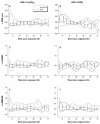Interaction effects of ultrafine carbon black with iron and nickel on heart rate variability in spontaneously hypertensive rats
- PMID: 17637915
- PMCID: PMC1913579
- DOI: 10.1289/ehp.9821
Interaction effects of ultrafine carbon black with iron and nickel on heart rate variability in spontaneously hypertensive rats
Abstract
Background: Particulate matter (PM) has been reported to be associated with alterations in heart rate variability (HRV); however, the results are inconsistent. We propose that different components of PM cause the discrepancy.
Objective: In this study, our goal was to determine whether different types of exposure would cause different HRV effects, and to verify the interactions between co-exposing components.
Methods: Ultrafine carbon black (ufCB; 14 nm; 415 microg and 830 microg), ferric sulfate [Fe(2)(SO(4))(3); 105 microg and 210 microg], nickel sulfate (NiSO(4); 263 mug and 526 microg), and a combination of high-dose ufCB and low-dose Fe(2)(SO(4))(3) or NiSO(4) were intratracheally instilled into spontaneously hypertensive rats. Radiotelemetry data were collected in rats for 72 hr at baseline and for 72 hr the following week to determine the response to exposure. Effects of exposure on 5-min average of normal-to-normal intervals (ANN), natural logarithm-transformed standard deviation of the normal-to-normal intervals (LnSDNN), and root mean square of successive differences of adjacent normal-to-normal intervals (LnRMSSD) were analyzed using self-control experimental designs.
Results: Both high- and low-dose ufCB decreased ANN marginally around hour 30, with concurrent increases of LnSDNN. LnRMSSD returned to baseline levels after small initial increases. We observed minor effects after low-dose Fe and Ni instillation, whereas biphasic changes were noted after high-dose instillations. Combined exposures of ufCB and either Fe or Ni resulted in HRV trends different from values estimated from individual-component effects.
Conclusions: Components in PM may induce different cardioregulatory responses, and a single component may induce different responses during different phases. Concurrent exposure to ufCB and Fe or Ni might introduce interactions on cardioregulatory effects. Also, the effect of PM may be mediated through complex interaction between different components of PM.
Figures




References
-
- Adler V, Yin Z, Tew KD, Ronai Z. Role of redox potential and reactive oxygen species in stress signaling. Oncogene. 1999;18:6104–6111. - PubMed
-
- Arimoto T, Kadiiska MB, Sato K, Corbett J, Mason RP. Synergistic production of lung free radicals by diesel exhaust particles and endotoxin. Am J Respir Crit Care Med. 2005;171:379–387. - PubMed
-
- Avshalumov MV, Chen BT, Rice ME. Mechanisms underlying H2O2-mediated inhibition of synaptic transmission in rat hippocampal slices. Brain Res. 2000;882:86–94. - PubMed
-
- Bateson TF, Schwartz J. Who is sensitive to the effects of particulate air pollution on mortality? A case-crossover analysis of effect modifiers. Epidemiology. 2004;15:143–149. - PubMed
-
- Brook RD, Franklin B, Cascio W, Hong Y, Howard G, Lipsett M, et al. Air pollution and cardiovascular disease: a statement for healthcare professionals from the Expert Panel on Population and Prevention Science of the American Heart Association. Circulation. 2004;109:2655–2671. - PubMed
Publication types
MeSH terms
Substances
LinkOut - more resources
Full Text Sources
Medical

